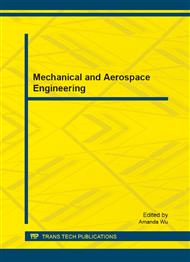[1]
Khandan R, Noroozi S, Sewell P, Vinney J, Ramazani MR. Optimum Design of Fibre Orientation Angles in Composite Laminate Plates for Minimum Thickness. ASME 2010 International Mechanical Engineering Congress & Exposition, 2010 Canada.
DOI: 10.1115/imece2010-40424
Google Scholar
[2]
Reissner E, Stavsky Y. Bending and Stretching of Certain Types of Aeolotropic Elastic Plates. Journal of Applied Mechanics 1961; 28: 402–408.
DOI: 10.1115/1.3641719
Google Scholar
[3]
Reddy JN. Mechanics of Laminated Composite Plates And Shells. 2004 Second Edition, CRC Press, New York.
Google Scholar
[4]
Mindlin RD. Influence of rotary inertia and shear on flexural motions of isotropic elastic plates. J Appl Mech ASME 1951; 18: 31–36.
DOI: 10.1115/1.4010217
Google Scholar
[5]
Liew KM, Wang J, Tan MJ, Rajendran S. Nonlinear analysis of laminated composite plates using the mesh-free kp-Ritz method based on FSDT. Comput. Methods Appl. Mech. Eng. 2004: 193; 4763–4779.
DOI: 10.1016/j.cma.2004.03.013
Google Scholar
[6]
Savithri S, Varadan TK. Large deflection analysis of laminated composite plates. Int. J. Non-Linear Mech. 1993; 28(1): 1–12.
DOI: 10.1016/0020-7462(93)90002-3
Google Scholar
[7]
Ovesy HR, Assaee H. The influence of bend-twist coupling on the post-buckling characteristics of composite laminated plates using semi-energy finite strip approach. Thin-Wall Struct 2007; 45: 209–20.
DOI: 10.1016/j.tws.2007.01.016
Google Scholar
[8]
Shufrin I, Rabinovitch O, Eisenberger M. Buckling of symmetrically laminated rectangular plates with general boundary conditions – a semi analytical approach. Composite Structures 2008: 82; 521–531.
DOI: 10.1016/j.compstruct.2007.02.003
Google Scholar
[9]
Bisagni C, Vescovini R. Analyticalformulationforlocalbucklingandpost-bucklinganalysis of stiffenedlaminatedpanels. Thin-Walled Structures 2009; 47: 318–334.
Google Scholar
[10]
Lopatin AV, Morozov EV. Buckling of the SSCF rectangular orthotropic plate subjected to linearly varying in-plane loading. Composite Structures 2011; 93: 1900–(1909).
DOI: 10.1016/j.compstruct.2011.01.024
Google Scholar
[11]
Daniel IM, Ishai O. Engineering Mechanics of Composite Materials. 2006 Second Edition, Oxford University Press.
Google Scholar
[12]
Saberi-Nadjafi J, Heidari M. Solving nonlinear integral equations in the Urysohn form by Newton-Kantorovich-quadrature method. Computers and Mathematics with Applications 2010; 60: 2058-(2065).
DOI: 10.1016/j.camwa.2010.07.046
Google Scholar


